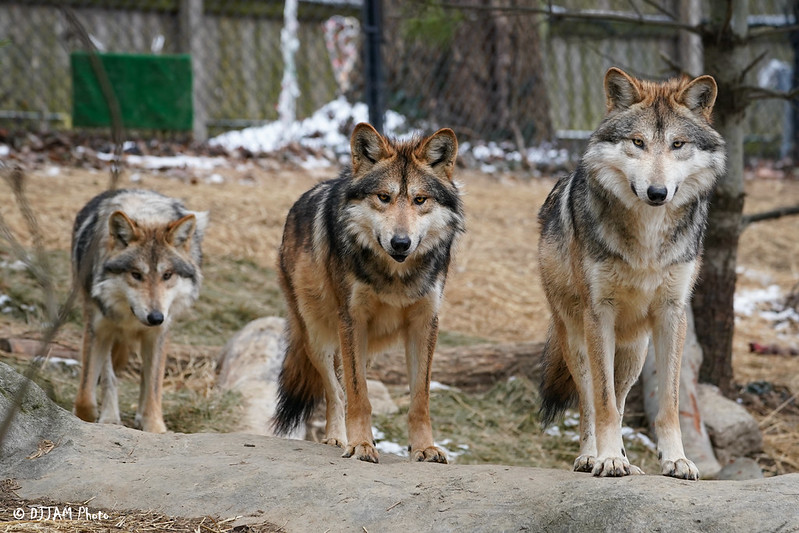Summary of Happy Lobo Week: Meet the Pack!:
Lobo Week celebrates the annual commemoration of reintroducing critically endangered Mexican gray wolves, or “Lobos,” into the wild in Arizona and New Mexico since 1998, after their previous extermination. The Mexican wolf, also known as “el lobo,” is the smallest subspecies of the North American gray wolf. It faces a unique challenge in its recovery efforts: the need for social tolerance rather than habitat management. The Cincinnati Zoo is home to four Mexican wolves: three brothers named Bruce, Shadow, and Waya, born on April 9, 2018, at the Endangered Wolf Center, and a female named Elena, born on May 14, 2021, also from the Endangered Wolf Center.
– Mexican gray wolves, or “Lobos,” are critically endangered animals reintroduced to Arizona and New Mexico wilds.
– Lobo Week celebrates the successful reintroduction of these wolves since 1998, highlighting conservation efforts.
– Social tolerance, rather than habitat management, is the main challenge in recovering the Mexican wolf.
– The Cincinnati Zoo houses four Mexican wolves, serving as an educational resource and a participant in conservation efforts.
The history of the Mexican gray wolf, or “Lobo,” is a captivating testament to nature’s resilience and the power of concerted conservation efforts. Lobos, once common across Mexico, Arizona, New Mexico, Texas, and even parts of California, faced relentless extermination campaigns in the early 20th century, leading to their near extinction. Lobo Week marks the anniversary of a significant turning point in this narrative: the reintroduction of the Mexican wolf to its native habitats in 1998. This event was a milestone in conservation history and a beacon of hope for the recovery of critically endangered species.
The Minnesota wolf plays a crucial role within its ecosystem. As the smallest subspecies of the North American gray wolf, it packs a significant ecological punch. Predators like the Lobo are essential for maintaining healthy populations of other animals by keeping herbivore numbers in check. This, in turn, prevents overgrazing and supports a balance within their ecosystems. Understanding the ecological importance of the lobo can foster greater appreciation and support for their conservation.
One of the most intriguing aspects of the Mexican wolf’s story is the shift from traditional conservation strategies toward addressing social tolerance issues. Historically, endangered species recovery has focused on habitat management and restoration. However, the primary challenge in recovering the Mexican wolf is cultivating coexistence between wolves and human communities. This involves extensive educational programs, policy advocacy, and community engagement initiatives designed to mitigate human-wolf conflicts and foster a culture of conservation.
The Cincinnati Zoo & Botanical Garden plays a pivotal role in conserving the Mexican wolf. Home to four Mexican wolves, Bruce, Shadow, Waya, and Elena, the zoo offers a haven for these animals and a vital educational platform. Born in captivity as part of a strategic breeding program to preserve genetic diversity, these wolves are ambassadors for their wild counterparts. The information shared with zoo visitors about the wolves’ history, biology, and conservation challenges is crucial for raising awareness and support for wild populations.
Moreover, the efforts undertaken by zoos like Cincinnati are part of broader, collaborative conservation initiatives. These programs involve scientific research, habitat restoration, and political advocacy to create a sustainable future for the Mexican wolf. By participating in these efforts, the zoo contributes to the preservation of a single species and the broader goals of biodiversity conservation and ecological resilience.
In summary, Lobo Week is not merely a celebration of a successful reintroduction program; it is a testament to the ongoing commitment of conservationists, biologists, and the public to rectify past mistakes and forge a sustainable coexistence with the natural world. The story of the Mexican wolf’s gradual return to the wild serves as a powerful example of what can be achieved when science, policy, and community support converge toward common conservation goals.
The Mexican wolf’s journey is far from over, but the progress made since their reintroduction in 1998 offers valuable lessons in conservation, resilience, and collaborative effort. As such, every Lobo Week offers an opportunity not just to celebrate but to reaffirm our commitment to preserving the natural heritage of North America for generations to come.


